
Smoked meat has been tantalizing taste buds for centuries. It’s got this rich, unique history that makes you appreciate every bite a little more. Turn back the clock, and you’ll find ancient smoking techniques used by countless cultures to preserve and flavor food. Smoking isn’t just surviving; it’s thriving.
Ever bitten into a piece of smoked brisket and felt like you were tasting stories 500 years in the making? That’s no coincidence. Smoke brings layers and depth, a kind of complexity that tickles all your senses. Your nose picks up earthy, woody aromas even before your taste buds get to celebrate, and the eyes feast on that rich mahogany shade dripping with promise.
Now, let’s break this down scientifically. When you smoke meat, the smoke particles latch onto the surface, doing a little dance with the proteins and fats. This dance creates new compounds that enhance flavor in ways raw or grilled meat simply can’t. Think of it as a kind of slow motion flavor evolution. And guess what? Your senses are all in on this.
Smoking transforms the meat, adding moisture and tenderness. Those hours spent in a smoker aren’t wasted; they’re adding depth, a medley of flavors that a quick grill can’t quite replicate. It’s like comparing a quick sketch to a Renaissance painting, both have merits, but one’s got history, depth, layers.
So, if you’ve wondered why smoked meat has this edge over grilled, it all comes down to chemistry, culture, and an extravagant dance of senses. Embrace the smoke, and let your senses run wild.
The Culinary Craft of Smoking: More Than Just Taste
Smoking is an art form. You know how some dishes are an orchestra of flavors? Smoking is like that but with each wood type playing solo. Hickory, cherry, mesquite—each brings its own vibe to the meat. Hickory adds a bold, almost bacon-like flavor, while applewood keeps things sweet and mild. It’s like a different game just choosing your smoke type.
Smoked meat isn’t something you rush. Sorry to all the impatient cooks out there, but this technique demands time and attention. While grilling is more like a sprint, smoking is a marathon. The low and slow approach allows flavors to seep deep into the meat, creating that tenderness that breaks hearts—while grilling usually chars meats quickly at higher temperatures.
The way smoking and grilling differ is almost poetic. Grilling may sear outside crusts perfectly, but it rarely lets flavors seep below the surface. Smoking lets the aromas and flavors play further inside. The result is a more nuanced flavor, like comparing a single note to a complex melody.
Being at the smoker’s helm isn’t just about flicking the on switch. It’s about understanding temperatures, knowing when to adjust air intake, and recognizing when the wood chips give off just the right amount of smoke. This control is what transforms humble cuts of meat into something legendary.
If you’re looking to start your smoking journey, say hello to a world waiting to reveal secrets through practice, patience, and maybe a few burnt pieces along the way. But remember, every smoky triumph started with seasoning and just the right amount of curiosity. Just like that, you’re in the smoker’s club.
Unlocking Aroma and Texture: Why Smoke Penetrates Deeper
When it comes to flavor and aroma, smoked meat is an all-rounder that just keeps giving. Ever notice how the aroma hits you before the meat is even on your plate? Smoke’s magic lies in its ability to wrap every inch of the meat in a warm, flavorful hug.
This deep penetration is all thanks to the smoke’s particles. These tiny bits squeeze into every nook and cranny of the meat, creating a complex profile that’s harder to achieve with grilling. While grilling concentrates on the outside, smoke dives into the meat, infusing it thoroughly with its distinct charm.
Texture is another game changer when it comes to smoking. The sustained low heat allows collagen in the meat to break down slowly, turning into gelatin that keeps the meat juicy. Meanwhile, the smoky envelope creates a crispy, flavor-packed crust that pairs beautifully with the tender center.
Grilled meat can be tender too, but smoking uniquely combines tenderness with that irresistible smoky flavor that makes you keep going back for seconds. It’s for those who like their meat to tell a story, a savory tale from crust to core.
Thinking about switching up your meats? Smoking might just be your best friend. It elevates lesser cuts, making them taste gourmet with the right handling and patience. So if you’re up for an adventure, smoke your way to a new level of cooking.
Cultural and Emotional Connections: The Art and Tradition of Smoking Meat
Smoking meat isn’t just about the flavors—it’s a cultural cornerstone that bonds and builds memories. Throughout history, communities worldwide have used smoking to preserve food, often gathering together, sharing stories, and enriching family traditions.
In many cultures, the tradition of smoking meat is almost ceremonial. It’s like an event—a gathering where families or neighborhoods come together, swapping tips and sharing marinades. From the American South’s legendary barbecues to European smoked sausages, the ritual of smoking has deep roots.
Every puff of smoke carries with it an echo of past generations. Cooking over a smoker is about more than just food; it’s embracing an experience that ties us to our ancestors. When you start smoking meat, you’re literally reliving history as you honor these timeless traditions.
Smoking rituals evoke powerful emotions and memories. Think about the comforting smell of wood, the sizzle of juices meeting the heat, and how certain tastes rocket you back to a time and place filled with laughter and camaraderie. For many, smoking meat feels like coming home.
Famous regional dishes like Texas brisket, Irish smoked salmon, or even Jamaican jerk chicken remind us that smoking is a shared heritage. Exploring these flavors takes you on a journey not just through regions, but through shared human experiences.
Health Considerations and Trends: The Modern Smoker’s Dilemma
While smoked meat is a joy for the senses and the soul, thinking about health is critical when indulging in this flavorful delight. Natural smoke can create potentially harmful chemicals, but fear not, balance is the key.
Choosing quality over quantity matters. Some oils and certain fats, when exposed to smoke, can form compounds like PAHs, which research links to health issues when overconsumed. Solution? Opt for leaner cuts and quality wood for cleaner smoke, keeping indulgences occasional.
On the bright side, smoked meats often require less additional fat in cooking, which can be a healthier choice compared to frying. Plus, they boast significant flavor keeping portion sizes smaller and satisfaction high, making moderation more manageable.
Nutritionally, smoked meats offer protein-packed options with complex flavor layers. This satisfies cravings better and helps avoid the empty calories of other fast cooking methods, serving as an effective alternative for those looking to maintain a balanced diet.
Smoking has evolved thanks to modern food tech pushing boundaries with electric and automated smokers, making the process more accessible. Experimenting with smoke flavors and techniques is trending, allowing more home cooks to embrace smoking without needing a big backyard pit.
If you’re stepping into the world of smoking, consider it a path lined with delicious potential but one that also requires mindfulness about consumption and technique. Embrace the trends but keep the tradition alive by smoking responsibly for the best of enjoyment and health.
